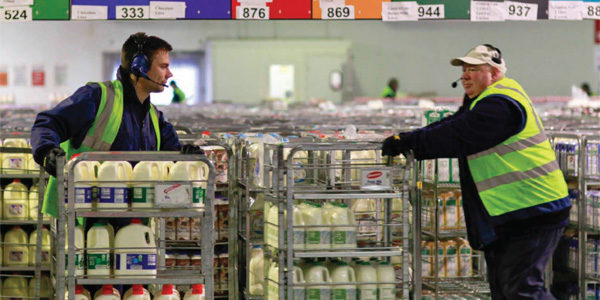Milking the system

When it comes to distribution applications for voice technology, people tend to assume the story begins and ends with order picking. That's no surprise given the kinds of productivity and accuracy gains voice users have reported over the decades.
But it turns out picking is just part of the story. As a number of users have discovered, voice technology can bring the same types of advantages to other DC processes, such as receiving, putaway, replenishment, load building, cycle counting, inventory management, and shipping. In fact, voice can be used to streamline nearly every aspect of distribution center management.
Glanbia, an international provider of milk, cheese, dairy foods, and nutritional products, is a case in point. For nearly three years now, the company, which is headquartered in Kilkenney, Ireland, has been using voice technology to direct not just picking operations, but also activities like receiving, putaway, and loading at its Irish dairy facilities.
What started Glanbia down this road was its growing frustration with the manual processes it was using at the time. "We were solely a paper-based operation," explains John Mee, the company's supply chain manager. "Replenishment, for instance, was all manual. A person had to follow directions on paper and look for a replenishment slot."
Trouble was, that was proving to be both time consuming and error prone. It wasn't unusual for papers to be misplaced or products to be put in the wrong places. "Our labor costs were high, but we were getting these high errors and less-than-optimal productivity rates," Mee says. "We knew we were not as effective and efficient as we should be."
On top of that, the paper systems did not provide real-time inventory information. Glanbia employees could not always find products, and when customers made credit claims, there was no good way to check the claims' validity. At the same time, Glanbia was under pressure to reduce costs.
Glanbia began working with its technology integration partner, Heavey RF of Ireland, to investigate alternatives that would reduce costs and resolve its other distribution challenges. They soon determined that voice-directed technology offered the flexibility to work in many different areas of Glanbia's operations. Also, because voice systems typically have a return on investment of less than a year, the technology would provide the fast payback Glanbia required.
The company installed voice systems from Vocollect at four sites, beginning in September of 2008 and finishing up in March of 2009. The voice systems now perform a number of operations in two milk manufacturing facilities and two distribution centers. One of the DCs distributes milk and cream products, which are bottle- and carton-based, while the other deals with other food products that are primarily case-based.
Creating a fluid process
The two milk plants operate entirely on voice for their distribution processes. Once the product is manufactured, the company's SAP warehouse management software assigns orders to trolleys, which are wheeled racks in a lattice framework approximately 5 feet, 8 inches tall. The trolleys, which act as both storage medium and conveyance for the milk, are used throughout the distribution process, even to the point of wheeling them into retail stores where the milk is offloaded directly onto store shelves.
When it comes time for orders to be picked, workers are guided to the appropriate storage locations through instructions received through their headsets. Upon arrival, they read off a check digit—a three-number code attached to or suspended above the location—to confirm they're in the right spot. The system then requests that the worker read off a "best before date" to the system to confirm that the product falls within the customers' requirements for expiration dates. The milk is picked onto the trolleys and the process is repeated until the trolley is full or the order is complete.
The trolleys are then wheeled directly to shipping, where the voice system provides instructions on where to place the milk prior to loading onto trucks. Some milk will ship directly to customers and agents (similar to brokers), while the rest will be sent in 40-foot trucks to the central milk warehouse.
The central milk warehouse turns its stock three times each day, so it doesn't actually store product—it merely stages it so that it can be picked for delivery by smaller route trucks. The facility operates 24 hours a day six days a week, turning out 1.6 million liters (approximately 422,675 gallons) of milk each day. "We have to turn these products quickly," says Mee. "It just has to keep flowing. We can't have any lost time."
Going with the flow
To ensure this quick flow through, voice is used in a number of processes within the central milk warehouse, including receiving products into the 23,000-square-foot facility. The "goods-in" receiving process starts with the driver's logging onto the voice system upon arrival. The voice system then prompts him to read off a delivery number listed on his dispatch paperwork. As the driver begins unloading the truck into the goods-in receiving area, he reads into the voice system the trolley's carrier number, which was attached to each trolley before it was shipped from the milk manufacturing center. This marries each trolley with the receipt.
A goods-in person will then complete the putaway process, also using Vocollect voice. The worker will read off the carrier number from the trolley, and the voice system—together with the SAP warehouse management software—will direct him or her to take the trolley to an assigned staging location for picking. The worker can also choose his or her own location by informing the voice system of the change. A check digit posted above each location must also be read to confirm the load is put away into the correct area. The worker confirms the putaway, the status of the load carrier is updated, and the stock is then available for picking.
A bar-code label attached to each trolley can also be scanned using a hand scanner at any point within the process. This will bring up a list of every item on the trolley, which can be helpful in resolving any inventory issues.
Once deposited in the putaway location, the milk is ready for picking. Some orders will require a full trolley of one SKU, while others call for multiple SKUs to be assembled onto one or more order trolleys. If the order requires multiple SKUs, the voice system will direct the worker to the lanes holding products for the order. Upon arrival at each location, the worker must read off the check digit displayed on the overhead sign to confirm the right slot has been reached. The voice system will then provide instructions on the number of cartons to pick onto the order trolley. The worker picks the items and confirms the quantity by reading the number of items picked back to the system. Best-before dates are also read into the voice system as items are picked to assure customer service requirements are met. Additional picks are made from other product trolleys.
Once the order is complete or the trolley is full, the voice system directs the worker to wheel the trolley to a marshaling area, where products are staged for loading. The system also provides the lane assignment for each trolley. As the worker deposits the trolley in a lane, he or she must read the check digit for that lane to confirm it's the right location.
Voice also directs the loading process. When an order is ready to ship, a loading person logs onto the voice terminal. He then reads a delivery docket number found on the dispatch sheet (similar to a packing slip) that is later given to the driver and accompanies the order in transit. The worker is then directed to load the truck in reverse delivery sequence, according to the unit carrier label attached to each trolley. The worker must read back the last four digits of this number to confirm that the correct trolley is being loaded onto the truck in the proper sequence. The process continues until the entire truck is loaded.
Vocollect's voice system is also used in Glanbia's food warehouse, where cases of products are picked from 1,000 positions in pallet racks onto order pallets. As in the other facilities, the voice system provides workers with instructions on which products to pick and confirms that all order requirements are being met.
Milking the benefits of voice
Voice has had a tremendous effect on productivity in the food warehouse, including a 60-percent increase since moving to the technology. Even greater increases have been realized in the central milk distribution center. In that facility, productivity has nearly doubled, with a 95-percent increase.
"Eliminating the paper means workers do not have to stop and mark their sheets. They instead keep moving," says Mee. "We also eliminated the dead time going back to the office to get additional paperwork. We have better locating now, so workers do not have to look for products. And we have less time spent rectifying errors. Overall, it is a much more fluid process."
These improvements in productivity have resulted in substantial labor savings. Work is also more flexible, as workers can be moved to whichever operation needs them the most. Once they are trained on voice, they merely have to follow the prompts for the new area, whether they're performing receiving, putaway, picking, or loading tasks. Soon, workers will also do inventory counts. Glanbia is hoping to interleave the counting process within putaway and picking operations for better overall inventory control and efficiencies.
Accuracy has also improved since moving to voice, with a 600-percent decrease in errors. This has resulted in a 45-percent drop in credit claims.
"The error rate reduction has been very noticeable by our customers," notes Mee. "We have reduced our claims, as we now know when a product was picked, who picked it, and what truck it went out on. It has brought us marketplace credibility and has lowered our supply chain costs, allowing us to remain competitive during a difficult economic environment."
Related Articles

Copyright ©2024. All Rights ReservedDesign, CMS, Hosting & Web Development :: ePublishing